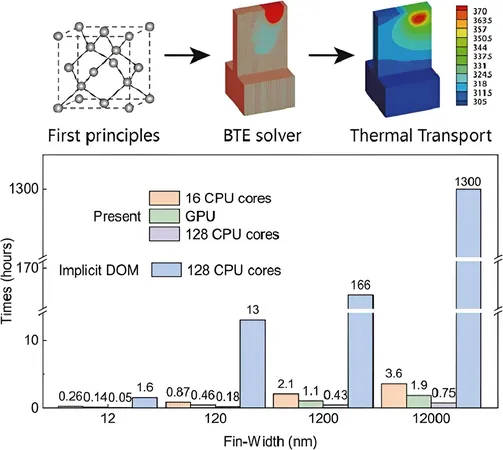
Groundbreaking Computational Method Tackles Major Challenges in Phonon-Based Heat Simulation!
2024-09-23
Introduction
As technology continues its relentless march toward miniaturization, managing heat in nanoscale electronics has become a significant hurdle, especially in devices measuring less than a micron. Traditional models of heat conduction fall short at this micro-level, where phonons—essentially energy carriers in the lattice structure—take front stage.
Challenges in Phonon-Based Heat Simulation
Two paramount challenges plague phonon-based heat simulation: first, the excessive dependence on empirical parameters that stifle the model's versatility across various materials, and second, the staggering computational burden associated with three-dimensional (3D) simulations.
Innovative Computational Method
In a groundbreaking study led by Professor Hua Bao and a team of researchers from Shanghai Jiaotong University, a novel computational method that effectively addresses these challenges has been unveiled. Their findings are published in the prestigious journal Fundamental Research.
Professor Bao explains, "When device dimensions shrink to the size comparable to the phonon mean free path, traditional Fourier's law becomes inadequate. To achieve accurate heat conduction modeling, we turn to the phonon Boltzmann transport equation (BTE). However, effectively solving this for 3D structures has historically been problematic."
Deriving Essential Parameters
The team innovated by implementing Fermi's golden rule to derive essential parameters directly from first principles, thus eradicating the need for empirical inputs. This means the new model can now be applied across a broad spectrum of materials while ensuring high precision.
Enhanced Simulation Speeds
Moreover, the introduction of cutting-edge numerical algorithms has significantly enhanced simulation speeds. A 3D FinFET device, traditionally requiring hundreds of CPU cores and several hours for a simulation, can now be executed on a standard desktop in less than two hours without losing accuracy.
Implications for Engineers
"Our method not only trims down computational expenses but also facilitates precise thermal modeling for intricate nanoscale architectures," adds Bao. "This offers crucial insights for engineers aiming to create materials imbued with tailored thermal properties and enables accurate temperature profiling at the level of individual transistors."
Open-Source Platform: GiftBTE
Not content to stop at algorithmic advancements, the researchers also rolled out GiftBTE, an open-source platform designed to push the envelope of sub-micron heat transfer simulation technology even further. The team hopes to inspire future research initiatives and catalyze practical applications in the realms of nanoelectronics and thermophysics.
Future Prospects
Professor Bao concludes, "We are optimistic that our research will spur other scientists to explore new dimensions for applications of BTE-based simulations, particularly within complex multi-physical realms such as electro-thermal coupling in devices."
Conclusion
This innovative approach could spell a revolution in how we design and manage the thermal properties of the next-generation electronic devices—an exciting frontier lies ahead in the pursuit of efficient, nanoscale technology!


 Brasil (PT)
Brasil (PT)
 Canada (EN)
Canada (EN)
 Chile (ES)
Chile (ES)
 España (ES)
España (ES)
 France (FR)
France (FR)
 Hong Kong (EN)
Hong Kong (EN)
 Italia (IT)
Italia (IT)
 日本 (JA)
日本 (JA)
 Magyarország (HU)
Magyarország (HU)
 Norge (NO)
Norge (NO)
 Polska (PL)
Polska (PL)
 Schweiz (DE)
Schweiz (DE)
 Singapore (EN)
Singapore (EN)
 Sverige (SV)
Sverige (SV)
 Suomi (FI)
Suomi (FI)
 Türkiye (TR)
Türkiye (TR)